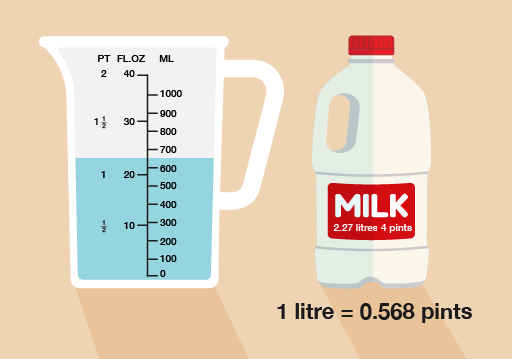4.2 Using pints and gallons
You might still see the old, imperial units for measuring volume.
- 20 fluid ounces (fl oz) = 1 pint (pt)
- 8 pts = 1 gallon (gal)
A pint is a little more than half a litre.
A fluid ounce is about 30 ml.
Some measuring jugs show both metric and imperial units.
Case study _unit3.4.3 Example: Buying petrol
You have an old one-gallon can in your shed. You take it to the garage to buy petrol for your lawnmower. About how many litres of petrol can you buy?
Method
A pint is a little more than half a litre, so you can get just over a litre for every 2 pints.
There are 8 pints in a gallon, so you can get just over 4 litres of petrol.
Now try the following activity. Remember to check your answers once you have completed the questions.
Activity _unit3.4.3 Activity 11: Converting between metric and imperial measurements
- You are mixing up a quantity of weedkiller. The packet says to use a pint of weedkiller in a gallon of water. You have only a metric measuring jug. How much water should you use with 1 litre of weedkiller?
- An old recipe book tells you to make one pint of custard. You prefer to buy custard in the supermarket, where it is sold in cartons of 500 ml. How many cartons do you need to buy to be sure you have enough for the recipe?
Answer
- You know that:
- 8 pts = 1 gallon (gal)
So you have to use eight times as much water as weedkiller.
If you use 1 litre of weedkiller, you will need 8 litres of water.
- A pint is a little more than half a litre, and the cartons of custard in the supermarket are 500 ml each. So to make one pint of custard, you would need to buy two cartons.
Summary
In this section you have learned how to:
- identify the standard units for measuring volume or capacity
- measure volume (or capacity)
- compare metric and imperial measures.

